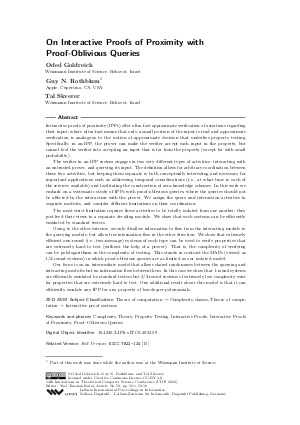@InProceedings{goldreich_et_al:LIPIcs.ITCS.2023.59,
author = {Goldreich, Oded and Rothblum, Guy N. and Skverer, Tal},
title = {{On Interactive Proofs of Proximity with Proof-Oblivious Queries}},
booktitle = {14th Innovations in Theoretical Computer Science Conference (ITCS 2023)},
pages = {59:1--59:16},
series = {Leibniz International Proceedings in Informatics (LIPIcs)},
ISBN = {978-3-95977-263-1},
ISSN = {1868-8969},
year = {2023},
volume = {251},
editor = {Tauman Kalai, Yael},
publisher = {Schloss Dagstuhl -- Leibniz-Zentrum f{\"u}r Informatik},
address = {Dagstuhl, Germany},
URL = {https://drops-dev.dagstuhl.de/entities/document/10.4230/LIPIcs.ITCS.2023.59},
URN = {urn:nbn:de:0030-drops-175625},
doi = {10.4230/LIPIcs.ITCS.2023.59},
annote = {Keywords: Complexity Theory, Property Testing, Interactive Proofs, Interactive Proofs of Proximity, Proof-Oblivious Queries}
}

 Creative Commons Attribution 4.0 International license
Creative Commons Attribution 4.0 International license
